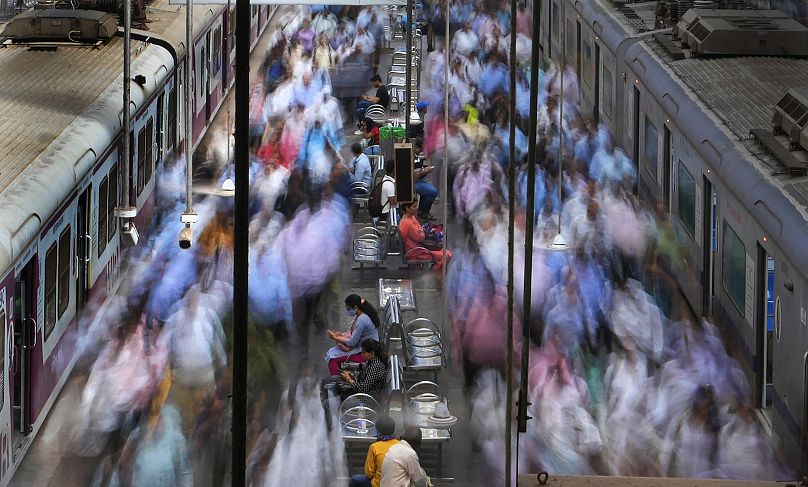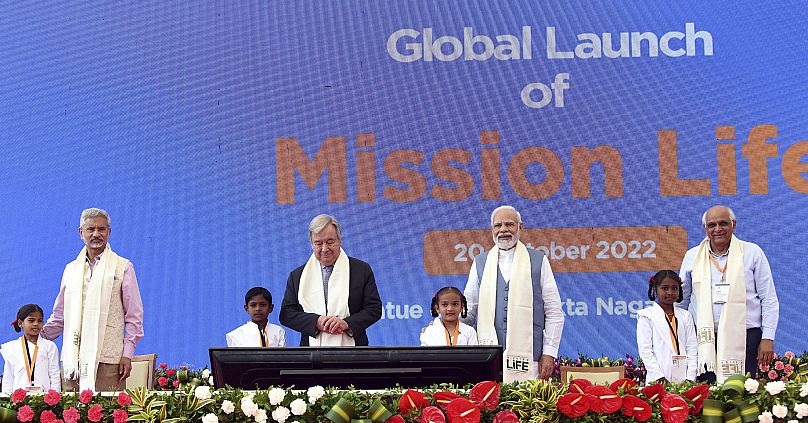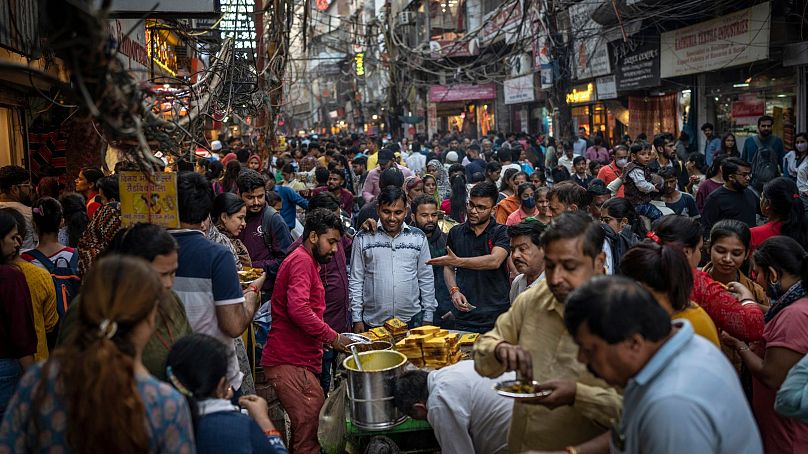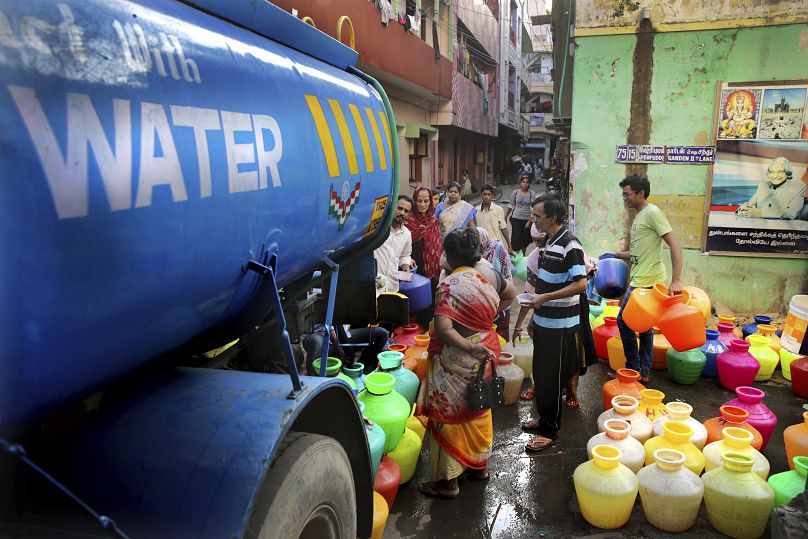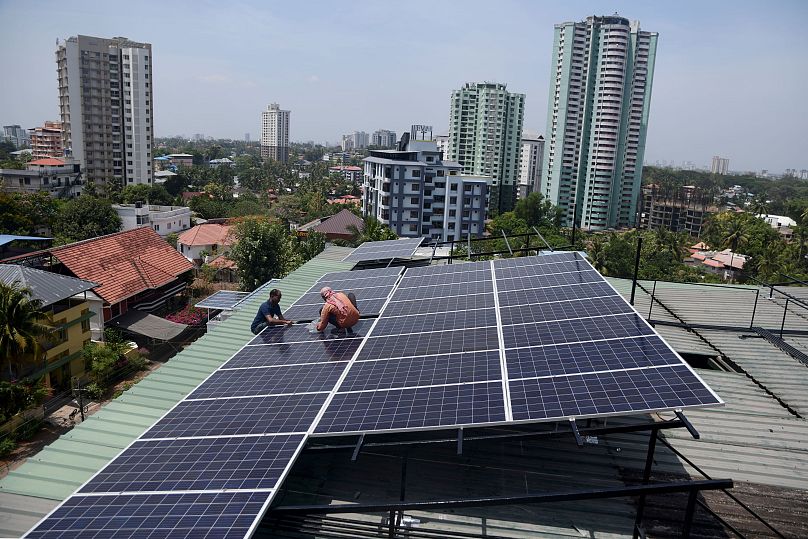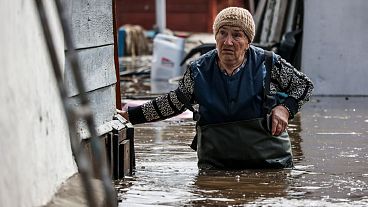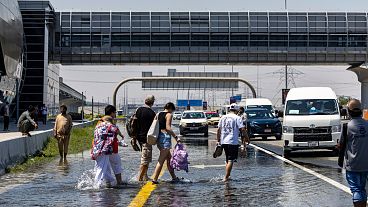‘A new economy for happiness’: Here's how experts think India can grow sustainably as its population passes 1.41 billion people.
Demographers are divided on whether it has happened already: the birth that tips India into being the most populated country in the world. With around 70,000 babies born every day in India and 50,000 in China, the south Asian nation is set to take the lead at some point this month, becoming home to more than 1.41 billion people.
Will the baby be born into an affluent home in Mumbai or a remote village in Bihar? Walk in the foothills of the Himalayas or row through the mangrove forests of Kerala? It’s impossible to know their fortunes in such a vast, socially and geographically diverse country.
All the details that make up a life get flattened out on a demographer’s curve. At a national level there are these hard certainties: India is bearing the brunt of a climate crisis that its countrymen and women have not historically caused. Their children are entitled to a share of the carbon budget that cannot burn without blowing the Earth off a safe course for all its inhabitants.
To an April baby born in India 2023, there are numbers that will matter more than the country’s growth rate (which has been slowing for decades; the population is set to peak in the 2060s). More pressing is the creep of the mercury in summer - already hitting 40C in this month’s heatwave - and the rise of the Air Quality Index, a measure of deadly pollution, in winter.
“We are at a stage where the remaining carbon budget is too small to divide among all countries,” says Minal Pathak, Associate Professor at Ahmedabad University and a Senior Scientist at the IPCC.
India has emitted more than 85,000 GTCO2 between 1850 and 2021, Carbon Brief analysis shows. That puts it a sizable seventh on the leaderboard of historically most polluting countries; with the caveat that it was already in 9th position when it gained independence from the British.
But accounting for population size paints a different picture. India’s cumulative emissions per population in 2021 was only 61 tCO2, far below the US total of 1,547 tCO2. The country’s carbon budget is calculated based on its much bigger population - and it's not nearly at the edges of it.
“The fairness argument cannot be an excuse for India to develop unsustainably,” Pathak adds. "However, this has to be seen in the context of equity and the failure of developed countries in taking ambitious climate action."
India is now the world’s third biggest emitter of greenhouse gases, after China and the US.
“Just because we didn’t create the problem doesn’t mean we go on building roads and following the mistakes some other countries have already made because we can see what’s happening,” she says. “We shouldn’t use that argument to our advantage and just continue on business as usual.”
Can development be compatible with cutting emissions?
What India’s population growth means in the short term is more young people. A UN Population Fund survey in 2020 found that 25 per cent of people in India are aged 14 and under, with 68 per cent in the 15-64 bracket. That means more jobs, more development, more growth - and almost certainly more consumption, fuelling even more emissions.
Measuring India’s progress against the UN’s 17 sustainable development goals shows the contours of “an uphill task” says Bhagirath Behera, Professor at the Indian Institute of Technology Kharagpur (IITK). More than 44 million people are still living in extreme poverty, and the country has “a huge malnutrition problem.”
Development is desperately needed in parts of India. But, says Pathak, “it’s that fine balance between providing enough energy, enough infrastructure to people for a decent quality of life, and checking overconsumption.”
How is India trying to tackle the climate crisis?
Prime Minister Narendra Modi’s net zero by 2070 target divided commentators when it was announced at COP26 in 2021. The cabinet followed up with more detail on its national climate plan last summer, pledging to reduce the “emissions intensity” of India’s GDP by 45 per cent below 2005 levels by 2030.
It also vowed that around half of its installed electricity generating capacity will come from non-fossil fuel sources by the end of the decade, provided finance is forthcoming from other countries.
And there is another, non-quantifiable element to the plan which goes by the acronym LiFE: Lifestyle for Environment. It’s described as a “one-word movement”, enlisting citizens “to live a lifestyle that is in tune with our planet and does not harm it.”
LiFE was fleshed out in the run up to COP27 in 2022, and it didn’t seem to make a real splash in the arena of serious ideas. Climate campaigners are wary of an onus on small individual actions like turning off lights, compared to the huge amounts of carbon that nations and corporations trade in.
But both Behera and Pathak lean into the need for lifestyle as well as policy change.
Are sustainable lifestyles part of the answer?
“If you go back to my mother’s time, India was sustainable. We were reusing, recycling, everything, and that changed. It changes when people become rich,” says Pathak. “Nowadays it looks like everyone aspires to be an American citizen of the eighties; those big houses with the lawns and the big cars… that’s a dream, that’s an aspiration that a lot of young people have.”
Pathak sees a “status thing” around consumption in India. “How do you make sustainability cool?” she ponders.
It’s a question with global relevance and no easy answer. And it circles back to the need for government support in providing attractive green options, like good quality public transport.
India’s growing renewables sector suggests a wealth of new green jobs, sorely needed given the employment rate is hovering around 8 per cent. But this won’t happen automatically, says Pathak. The current “skill mismatch” requires some thought - and perhaps a reassessment of how professions are valued. “We need to invest in other sectors where there are low emissions, but [also] more simple professions that give you a better sense of wellbeing,” she says.
Though it’s developed countries which should be engaging most urgently with post-growth living, Behera too has recently argued for a ‘new economy for happiness’. An expert in the sustainable use of natural resources, he concludes that “a radical transformation in the human psyche is required in order to reverse the ecological and economic crisis.”
“If we are aware of our daily activities, every moment, every minute, then there is a possibility that we can bring about a change in the world,” he tells Euronews Green.
Cities, water, coal: How is India changing?
India’s booming population is having a far-reaching impact on both its manmade and natural resources.
Easing the population pressure on India’s cities
“I think we are making a very big mistake on urban development,” says Pathak, an expert in climate and development in cities. India has five ‘megacities’ - defined as those with over 10 million inhabitants - and they are “bursting at the seams”. This is pushing people towards slums and informal settlements where they are most at risk from climate events.
Empowering India’s many smaller cities to draw more people is part of the answer, she says. Currently, megacities like Mumbai and Delhi are growing upwards - with enormous amounts of emission-intensive concrete and steel going into the high rises. Cities are building outwards too, over natural ecosystems like floodplains and lakes.
Challenging the clout of India’s powerful real estate lobby will require some political will, Pathak suggests. And city planning needs to soften the impact of climate extremes like heatwaves.
How can India make sure its citizens have enough water?
Many Indian states face acute water shortages, as demand increases and rainfall becomes more erratic. Rainwater harvesting is now mandatory for new buildings in a lot of cities, says Pathak.
Chennai, which veers between flooding and drought, ran out of water in 2019. Now it is leading on water saving practices, becoming the first Indian city to recycle wastewater at scale to meet the non-drinking needs of its industries.
Though water dynamics look very different across India, groundwater is the main source of both urban and rural drinking water. Given competing pressures from agriculture and industry too, the water table is getting “severely depleted”, warns Behera, raising its salinity level.
Government-led conservation efforts are helping to address this. The Mahatma Gandhi National Rural Employment Guarantee Scheme, for example, is paying workers to create water harvesting structures. Modi previously pledged to provide all rural households with safe piped water by 2024.
How fast is India switching from coal to renewables?
The reign of coal is, slowly, coming to an end in India. But the country is sending out mixed signals according to E3G’s Global Energy Monitor. Only 3.5 GW of new coal capacity was commissioned last year; the lowest annual addition since 2014 (excluding a pandemic slump).
However plans for new projects persist, and there are no clear retirement plans in place. “As is the case for China and other countries, simultaneously investing in both coal and renewables will only result in a messier energy transition for India,” the report says.
Renewables are cheaper than coal plants; but protectionist trade barriers - on imported solar components, for example - are hampering new solar and wind projects.
Energy experts are also keen to see India adopt a generation target for renewables by 2030, beyond the one on installed capacity announced in its NDC which does not take into account the whole energy system.
Other domestic policies speak to the competing demands of sustainable development. “The government has introduced very interesting policies to provide subsidised liquid natural gas (LNG) to the poorest people,” says Behera, “distributing the fuel to millions of households”.
Though still a fossil fuel, the gas is preferable to coal and firewood from both an emissions and health point of view.
India: Life, death and hope in a heating country
In the four years between 2017-2021, India saw a 55 per cent rise in deaths due to extreme heat compared with 2000-2004, a recent Lancet study found.
Record-breaking heatwaves are catalsying action to an extent. Ahmedabad became the first city to adopt a heat action plan a decade ago. Now developed and adopted nationwide, the plans include early warning systems, informing people to stay inside at certain times of the day.
As for the root causes, public discussion moves on with the seasons, says Pathak. But the scientist sees positive signs: the spread of electric buses and solar rooftops, for example. Scaling these up is key in such an enormous country.
Digitalisation is another significant trend Pathak sees with transformative potential, as phone penetration spreads to even the smallest villages. “How do you use that digitalisation to transform services to set the transition to a low carbon economy?” she asks.
Population growth touches on all aspects of life in India. It’s not just India’s human population that depends on the country curbing emissions and controlling its impact on ecosystems.
Living in the IITK campus in West Bengal, Behera is surrounded by deep tree canopy and birdsong. Last week he found a big snake in his bathroom, drawn to the water and cooler tiles. “Every species,” he says, “is suffering a great deal because they have never experienced such temperatures.”

